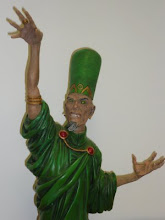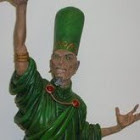 A hugely engaging and enjoyable biography of George Herriman, who created the newspaper comic Krazy Kat and developed it over an extraordinarily sustained period of creativity that lasted for decades.
A hugely engaging and enjoyable biography of George Herriman, who created the newspaper comic Krazy Kat and developed it over an extraordinarily sustained period of creativity that lasted for decades.There are two major themes in this book and Michael Tisserand does justice to both, the first is the racial context to George Herriman's life and the second is is life as a creative professional. George Herriman was a Creole from New Orleans who spent the greater part of his life declaring and being accepted as a white American, his nickname was George the Greek. George Herriman was committing the single most serious crime that he could carry out in social terms in the overtly racially divided USA of the time, he was "passing". By doing this he was directly confronting and undermining the most important tenant of the racial social creed, that a white person was intrinsically superior to non-white people and that their superiority was written on their skin for all to see. If in fact that skin was telling a lie, appearing to be white when the facts of family were otherwise was to effectively show up the complete nonsense for what it was, a lie put about by one group to support their dominance over others, a simple power play backed by nothing but violence and hatred.
No group responds well to such a direct and unassailable attack on something so precious to the structure of their lives, "passing" had fatal consequences for many, their treatment especially vicious to provide a warning to others.
George Herriman lived his life standing on this knife edge and never faltered, his secret was a secret for years after his death, Michael Tisserand carefully raises the question regarding exactly what George Herriman knew himself, his father had made a choice when George was very small so it is possible that he was not aware of his own heritage. Equally there are pieces of work that can be read without forcing the conclusion that he was aware of a hidden racial identity. Michael Tisserand does not step beyond the evidence, he does provide a very vivid context of the racial forces for forcefully and publicly at work in the USA. If George Herriman was conducting a fully conscious life as a Creole in a White skin then his ability to manage the mental strain and impact throughout his life without betraying himself in the slightest is the only aspect of his life more astounding than his work.
The second theme of this book is the extraordinary creative professional life of George Herriman, newspaper cartoonist. Michael Tisserand places George Herriman directly in his professional context as a member of a wide spread group who illustrated the news first and as photography took over provided comics for newspapers. George Herriman was part of a group of professional cartoonists who were together at the emergence of the art form and ho created many of its most enduring strips. The way that Krazy Kat developed from the desire to anchor a career in a continuing strip is deeply engaging, Krazy Kat was the end result of a lot of other efforts that had varying degrees of success until the star emerged. Having storming success with single strip comics, it was when Krazy was given a full page on a Sunday that George Herriman revealed the unplumbed depth of his creative genius. A simple framework of unrequited love between a kat, a mouse and a dog the confines that would choke another liberated George Herriman.
Krazy Kat in the Sundays never achieved the heights of popularity that others did, still it had a hugely loyal audience, though George Herriman spend his life downplaying his work and fretting that he would loose his employment.
Krazy is a very enjoyable book and a lovely tribute to an extraordinary man whose contribution to the sum total of human happiness is beyond measure.


No comments:
Post a Comment